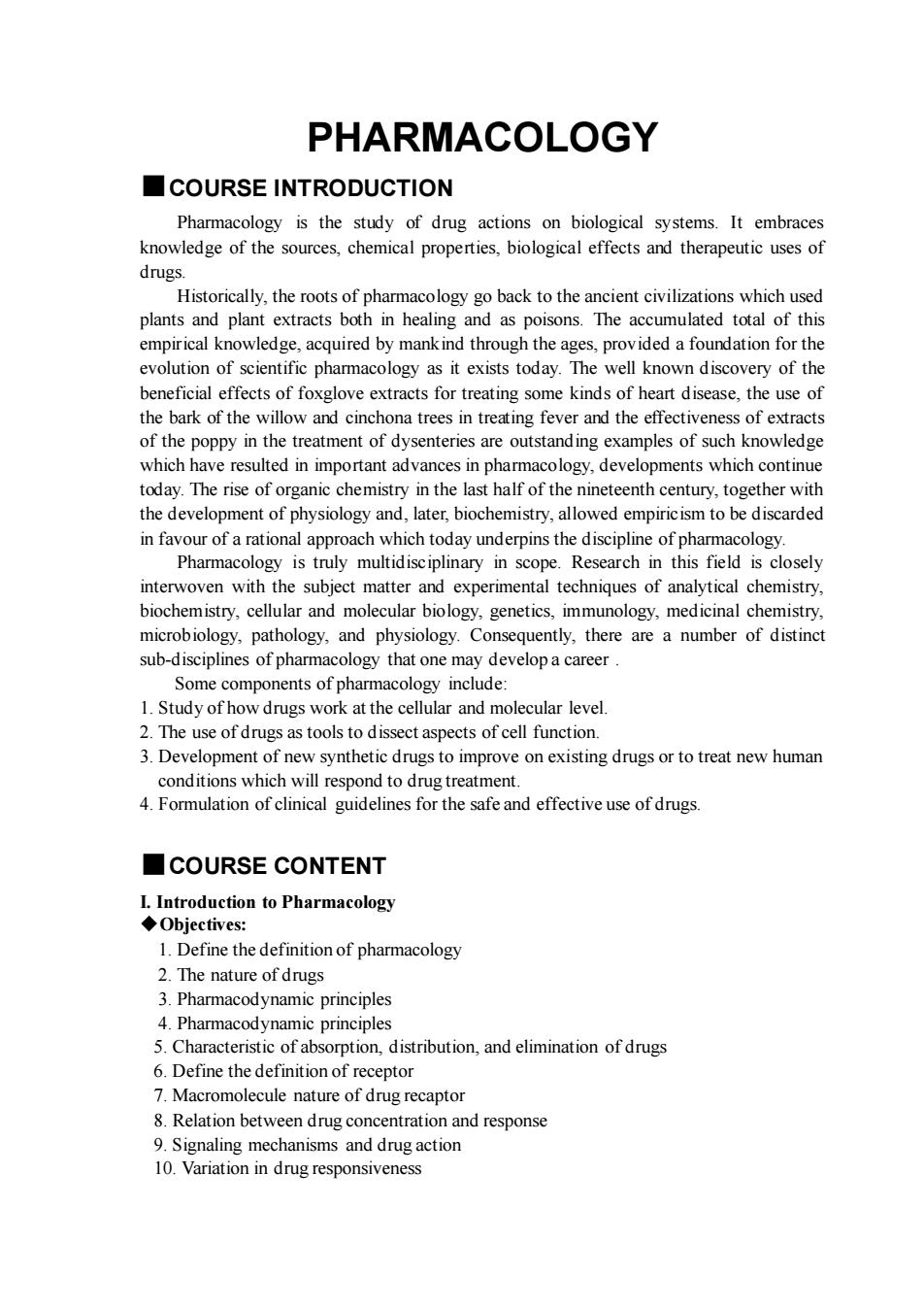
PHARMACOLOGY ■COURSE INTRODUCTION Pharmacology is the study of drug actions on biological systems.It embraces knowledge of the sources,chemical properties,biological effects and therapeutic uses of drugs. Historically,the roots of pharmacology go back to the ancient civilizations which used plants and plant extracts both in healing and as poisons.The accumulated total of this empircal by mankind throuh the ages,for the evolution of scientific pharmacology as it exists today.The well known discovery of the beneficial effects of foxglove extracts for treating some kinds of heart disease,the use of the bark of the willow and cinchona trees in treating fever and the effectiveness of extracts of the poppy in th reatmnt of dysenteries re outstanding examps of such which have resulted in important advances in pharmacology,developments which continue today.The rise of organic chemistry in the last half of the nineteenth century,together with the development of physiology and,later,biochemistry,allowed empiricism to be discarded in favour of a rational approach which today underpins the discipline of pharmacology. Pharmacology is truly multidisciplinary in scope.Research in this field is closely interwoven with the subject matter and experimental techniques of analytical chemistry. iochen and molecular biology,genetic immunology,medicinal chemistry microbiology,pathology,and physiology.Consequently,there are a number of distinct sub-disciplines of pharmacology that one may develop a career. Some components of pharmacology include: .Study of how drugs work at the cellular and molecular level 2.The use of drugs as tools to dissect aspects of cell function. 3.Development of new synthetic drugs to improve on existing drugs or to treat new human condtions which willrespnd to du treatment on of clinical guidelines for the safe and effective use of drugs ■COURSE CONTENT I.Introduction to Pharmacology ◆Objectives:. 1.Define the definition of pharmacology 2.The nature of drugs 3.Pharmacodynamic principles 4.Pharmacodynamic principles 5.Characteristic of absorption,distribution,and elimination of drugs 6.Define the definition of receptor 7.Macromolecule nature of drug recaptor 8.Relation between drug concentration and response 9.Signaling mechanisms and drug action 10.Variation in drug responsiveness
PHARMACOLOGY ■COURSE INTRODUCTION Pharmacology is the study of drug actions on biological systems. It embraces knowledge of the sources, chemical properties, biological effects and therapeutic uses of drugs. Historically, the roots of pharmacology go back to the ancient civilizations which used plants and plant extracts both in healing and as poisons. The accumulated total of this empirical knowledge, acquired by mankind through the ages, provided a foundation for the evolution of scientific pharmacology as it exists today. The well known discovery of the beneficial effects of foxglove extracts for treating some kinds of heart disease, the use of the bark of the willow and cinchona trees in treating fever and the effectiveness of extracts of the poppy in the treatment of dysenteries are outstanding examples of such knowledge which have resulted in important advances in pharmacology, developments which continue today. The rise of organic chemistry in the last half of the nineteenth century, together with the development of physiology and, later, biochemistry, allowed empiricism to be discarded in favour of a rational approach which today underpins the discipline of pharmacology. Pharmacology is truly multidisciplinary in scope. Research in this field is closely interwoven with the subject matter and experimental techniques of analytical chemistry, biochemistry, cellular and molecular biology, genetics, immunology, medicinal chemistry, microbiology, pathology, and physiology. Consequently, there are a number of distinct sub-disciplines of pharmacology that one may develop a career . Some components of pharmacology include: 1. Study of how drugs work at the cellular and molecular level. 2. The use of drugs as tools to dissect aspects of cell function. 3. Development of new synthetic drugs to improve on existing drugs or to treat new human conditions which will respond to drug treatment. 4. Formulation of clinical guidelines for the safe and effective use of drugs. ■COURSE CONTENT I. Introduction to Pharmacology ◆Objectives: 1. Define the definition of pharmacology 2. The nature of drugs 3. Pharmacodynamic principles 4. Pharmacodynamic principles 5. Characteristic of absorption, distribution, and elimination of drugs 6. Define the definition of receptor 7. Macromolecule nature of drug recaptor 8. Relation between drug concentration and response 9. Signaling mechanisms and drug action 10. Variation in drug responsiveness
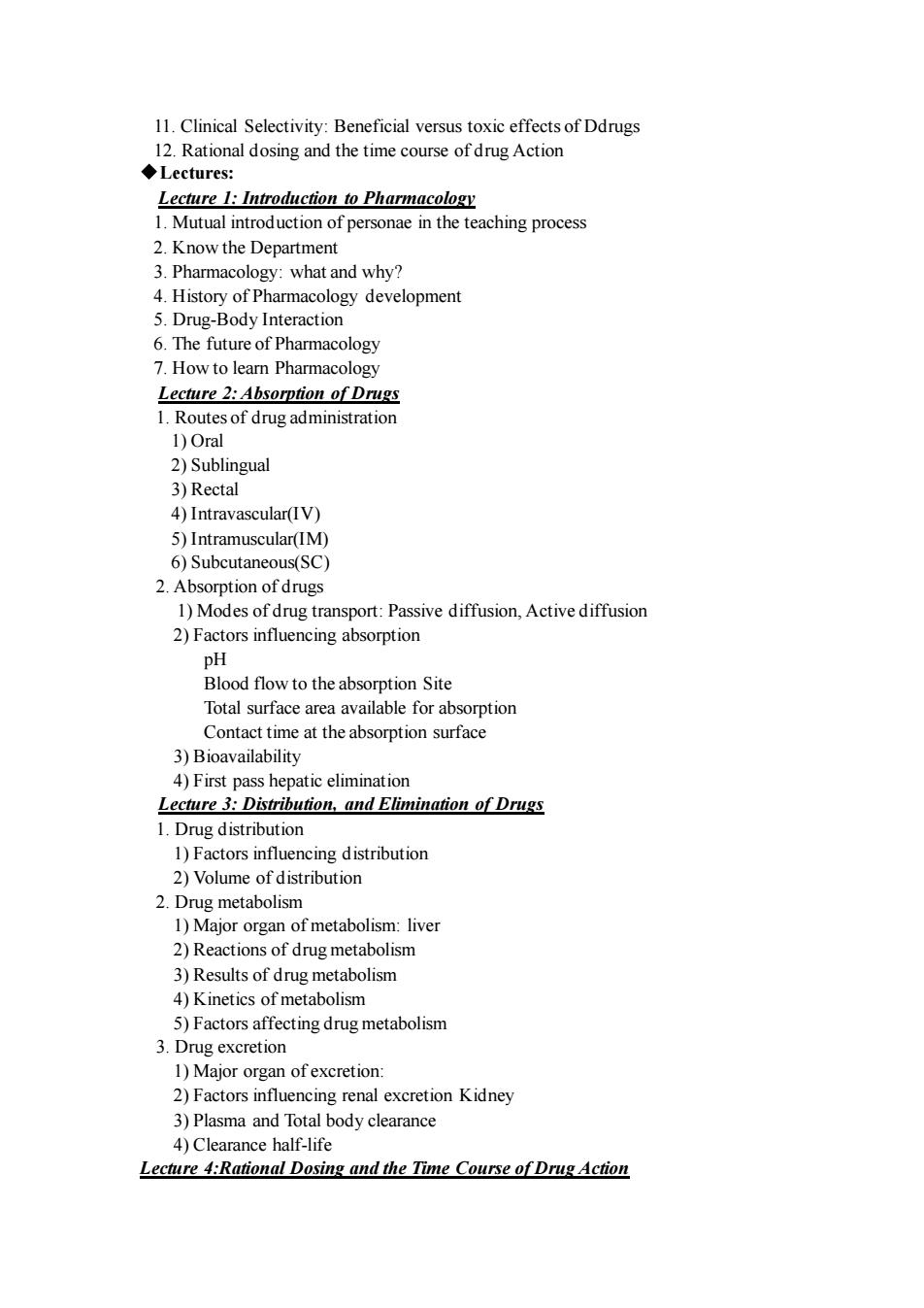
11.Clinical Selectivity:Beneficial versus toxic effects of Ddrugs 12.Rational dosing and the time course ofdrug Action Lectures Lecture 1:Introduction to Pharmacology 1.Mutual introduction of personae in the teaching process 2.Know the Department what and why? 4.History of P rmacology development 5.Drug-Body Int ractio 6.The future of Pharmacology 7.How to learn Pharmacolog utes of drug ac ministratio 2)Sublingual 3)Rectal 4)Intravascular(V) 5)Intram IM )Subcutaneous(SC 2.Absorption of drugs 1)Modes of drug transport:Passive diffusion,Active diffusion 2)Factors influencing absorption tion Sit lotal surface area available for absorption Contact time at the absorption surface 3)Bioavailability 4)First pass hepatic elimination 1.Drug distribution 1)Factors influencing distribution 2)Volume of distribution 2.Drug metabolism 1)Major organ of metabolism:liver 2)Reacti of drug metabolism 3)Results of drug metabolism 4)Kinetics of metabolism 5)Factors affecting drug metabolism 3.Drug excretion 1)Mai of excretion encing renal excretion Kidney 3)Plasma and Total body clearance 4)Clearance half-life Lecture 4:Rational Dosing and the Time Course of Drug Action
11. Clinical Selectivity: Beneficial versus toxic effects of Ddrugs 12. Rational dosing and the time course of drug Action ◆Lectures: Lecture 1: Introduction to Pharmacology 1. Mutual introduction of personae in the teaching process 2. Know the Department 3. Pharmacology: what and why? 4. History of Pharmacology development 5. Drug-Body Interaction 6. The future of Pharmacology 7. How to learn Pharmacology Lecture 2: Absorption of Drugs 1. Routes of drug administration 1) Oral 2) Sublingual 3) Rectal 4) Intravascular(IV) 5) Intramuscular(IM) 6) Subcutaneous(SC) 2. Absorption of drugs 1) Modes of drug transport: Passive diffusion, Active diffusion 2) Factors influencing absorption pH Blood flow to the absorption Site Total surface area available for absorption Contact time at the absorption surface 3) Bioavailability 4) First pass hepatic elimination Lecture 3: Distribution, and Elimination of Drugs 1. Drug distribution 1) Factors influencing distribution 2) Volume of distribution 2. Drug metabolism 1) Major organ of metabolism: liver 2) Reactions of drug metabolism 3) Results of drug metabolism 4) Kinetics of metabolism 5) Factors affecting drug metabolism 3. Drug excretion 1) Major organ of excretion: 2) Factors influencing renal excretion Kidney 3) Plasma and Total body clearance 4) Clearance half-life Lecture 4:Rational Dosing and the Time Course of Drug Action
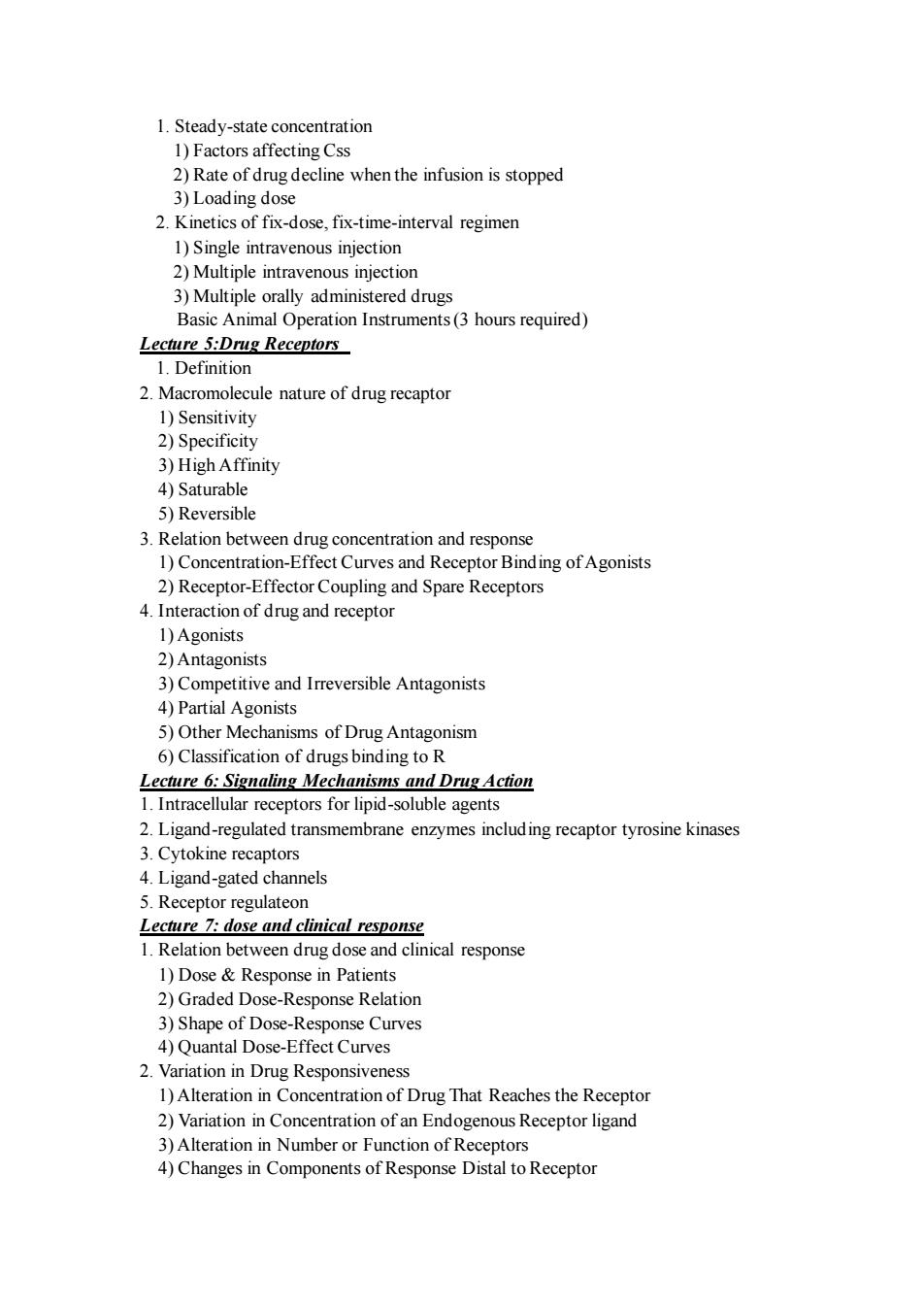
1.Steady-state concentration 1)Factors affecting Cs 2)Rate of drug decline when the infusion is stopped 3)Loading dose 2.Kinetics of fix-dose,fix-time-interval regimen 1)Single intravenous injection 2)Multiple intr venous injectic 3)Multiple orally administered drugs Basic Animal Operation Instruments(3 hours required) Lecture 5:Drug Receptors 1.Definition 2.Macromolecule nature of drug recaptor 1)Sensitivity 2)Specificity 3)High Affinitv 4)Saturable 5)Reversible 1)Concentration-Effect Curves and Receptor Binding ofAgonists 2)Receptor-Effector Coupling and Spare Receptors 4.Interaction of drug and receptor 1)Agonists 2)Antagonists 3)Competitive and Irreversible Antagonists 4)Partial Agonists 5)Other mechanisms of drug antagonism 6)Classification of drugs binding to R Lecture 6:Signaling Mechanisms and dr ug Action .Intracellular receptors for lipid soluble agents 2.Ligand-regulated transmembrane enzymes including recaptor tyrosine kinases 3.Cytokine recaptors 4.Ligand-gated channels 5.Receptor regulateon Lecture 7:dose and clinical respons 1.Relat ionbetween inca espons 1)Dose Response in Patients 2)Graded Dose-Response Relation 3)Shape of Dose-Response Curves 4)Qua ntal Dose-Effec rves 2.Va tion in Drug Responsivenes 1)Alteration in Concentration of Drug That Reaches the Receptor 2)Variation in Concentration of an Endogenous Receptor ligand 3)Alteration in Number or Function of Receptors 4)Changes in Components of Response Distal to Receptor
1. Steady-state concentration 1) Factors affecting Css 2) Rate of drug decline when the infusion is stopped 3) Loading dose 2. Kinetics of fix-dose, fix-time-interval regimen 1) Single intravenous injection 2) Multiple intravenous injection 3) Multiple orally administered drugs Basic Animal Operation Instruments (3 hours required) Lecture 5:Drug Receptors 1. Definition 2. Macromolecule nature of drug recaptor 1) Sensitivity 2) Specificity 3) High Affinity 4) Saturable 5) Reversible 3. Relation between drug concentration and response 1) Concentration-Effect Curves and Receptor Binding of Agonists 2) Receptor-Effector Coupling and Spare Receptors 4. Interaction of drug and receptor 1) Agonists 2) Antagonists 3) Competitive and Irreversible Antagonists 4) Partial Agonists 5) Other Mechanisms of Drug Antagonism 6) Classification of drugs binding to R Lecture 6: Signaling Mechanisms and Drug Action 1. Intracellular receptors for lipid-soluble agents 2. Ligand-regulated transmembrane enzymes including recaptor tyrosine kinases 3. Cytokine recaptors 4. Ligand-gated channels 5. Receptor regulateon Lecture 7: dose and clinical response 1. Relation between drug dose and clinical response 1) Dose & Response in Patients 2) Graded Dose-Response Relation 3) Shape of Dose-Response Curves 4) Quantal Dose-Effect Curves 2. Variation in Drug Responsiveness 1) Alteration in Concentration of Drug That Reaches the Receptor 2) Variation in Concentration of an Endogenous Receptor ligand 3) Alteration in Number or Function of Receptors 4) Changes in Components of Response Distal to Receptor
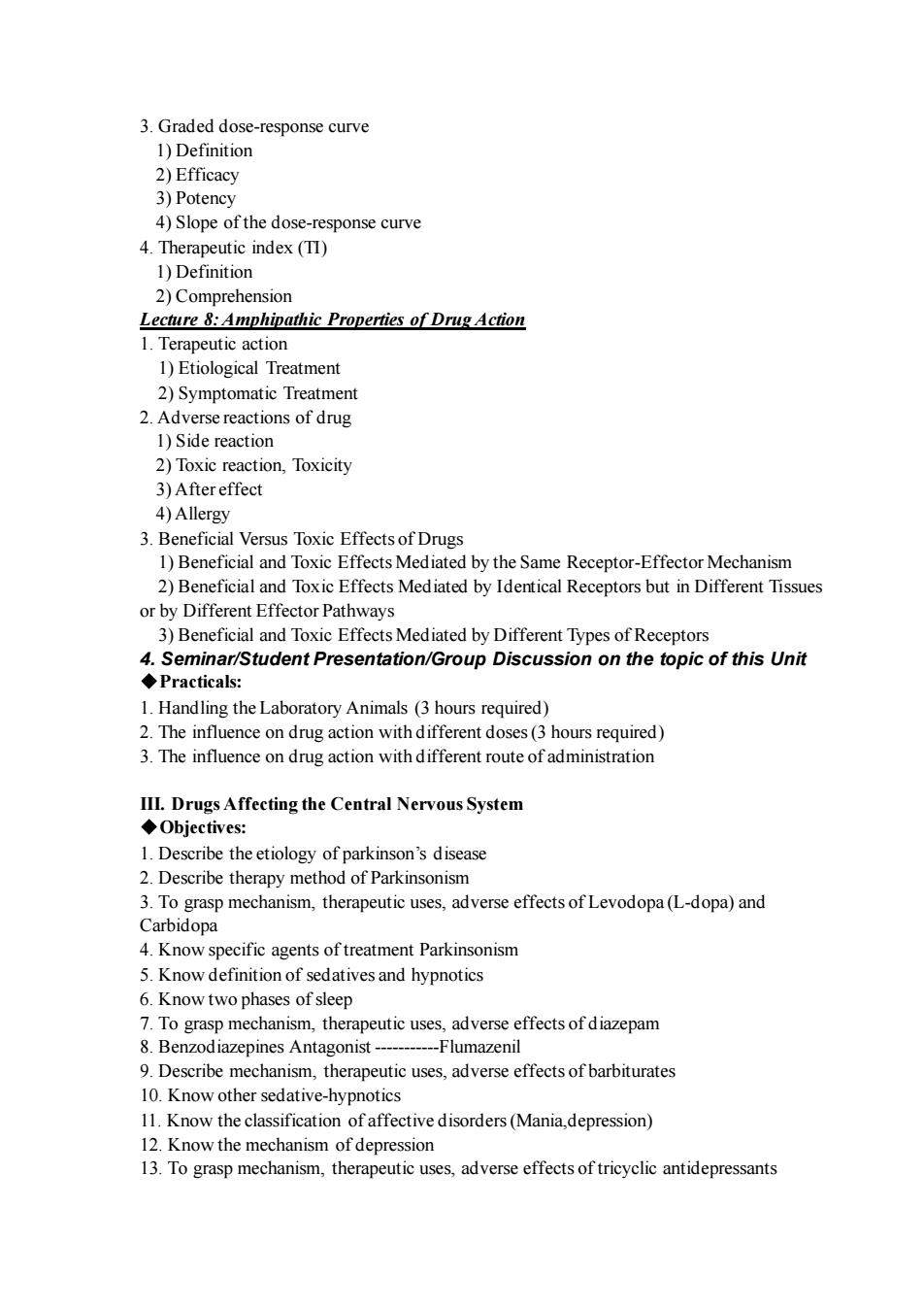
3.Graded dose-response curve 1 Definition 2)Efficacy 3)Potency 4)Slope of the dose-response curve 4.Therapeutic index (TI) 1)Definition 2)Comprehe Lecture 8:Amphipathic Properties of Drug Action I.lerapeutic action 1)Etiological Treatment 2)Symptomatic Treatment 2.Ad rse reactions of drug 1)Side reaction 2)Toxic reaction.Toxicity 3)After effect 4)Allergy Benefici sToxic Effects of Drugs 1)Beneficial and ic Effects Media by the Same Receptor-Effector Mechanism 2)Beneficial and Toxic Effects Mediated by Identical Receptors but in Different Tissues or by Different effector Pathways 3)Beneficial and Toxic Effects Mediated by Different Types of Receptors 4.Seminar/Student Presentation/Group Discussion on the topic of this Unit ◆Practicals: 1.Handling the Laboratory Animals (3 hours required) 2.The influence on drug action with different doses(3 hours required) 3.The influence on drug action with different route of administration III.Drugs Affecting the Central Nervous System 1.Describe the etiology of parkinson's disease 2.Describe therapy method of Parkinsonism 3.To grasp mechanism,therapeutic uses,adverse effects of Levodopa(L-dopa)and Carbidopa 4.Know specific agents oftreatme Parkinsonisn 5.Know definition of sedatives and hypnotics 6.Know two phases of sleep 7.To grasp mechanism,therapeutic uses,adverse effects of diazepam 8 Benzodiazepines Antagonist --Flumazenil 9.Describe erap utic uses,adverse effects of barbiturates 10.Know other sedative-hypnotics 11.Know the classification of affective disorders(Mania,depression) 12.Know the mechanism of depression 13.To grasp mechanism,therapeutic uses,adverse effects oftricyclic antidepressants
3. Graded dose-response curve 1) Definition 2) Efficacy 3) Potency 4) Slope of the dose-response curve 4. Therapeutic index (TI) 1) Definition 2) Comprehension Lecture 8: Amphipathic Properties of Drug Action 1. Terapeutic action 1) Etiological Treatment 2) Symptomatic Treatment 2. Adverse reactions of drug 1) Side reaction 2) Toxic reaction, Toxicity 3) After effect 4) Allergy 3. Beneficial Versus Toxic Effects of Drugs 1) Beneficial and Toxic Effects Mediated by the Same Receptor-Effector Mechanism 2) Beneficial and Toxic Effects Mediated by Identical Receptors but in Different Tissues or by Different Effector Pathways 3) Beneficial and Toxic Effects Mediated by Different Types of Receptors 4. Seminar/Student Presentation/Group Discussion on the topic of this Unit ◆Practicals: 1. Handling the Laboratory Animals (3 hours required) 2. The influence on drug action with different doses(3 hours required) 3. The influence on drug action with different route of administration III. Drugs Affecting the Central Nervous System ◆Objectives: 1. Describe the etiology of parkinson’s disease 2. Describe therapy method of Parkinsonism 3. To grasp mechanism, therapeutic uses, adverse effects of Levodopa (L-dopa) and Carbidopa 4. Know specific agents of treatment Parkinsonism 5. Know definition of sedatives and hypnotics 6. Know two phases of sleep 7. To grasp mechanism, therapeutic uses, adverse effects of diazepam 8. Benzodiazepines Antagonist -----------Flumazenil 9. Describe mechanism, therapeutic uses, adverse effects of barbiturates 10. Know other sedative-hypnotics 11. Know the classification of affective disorders(Mania,depression) 12. Know the mechanism of depression 13. To grasp mechanism, therapeutic uses, adverse effects of tricyclic antidepressants
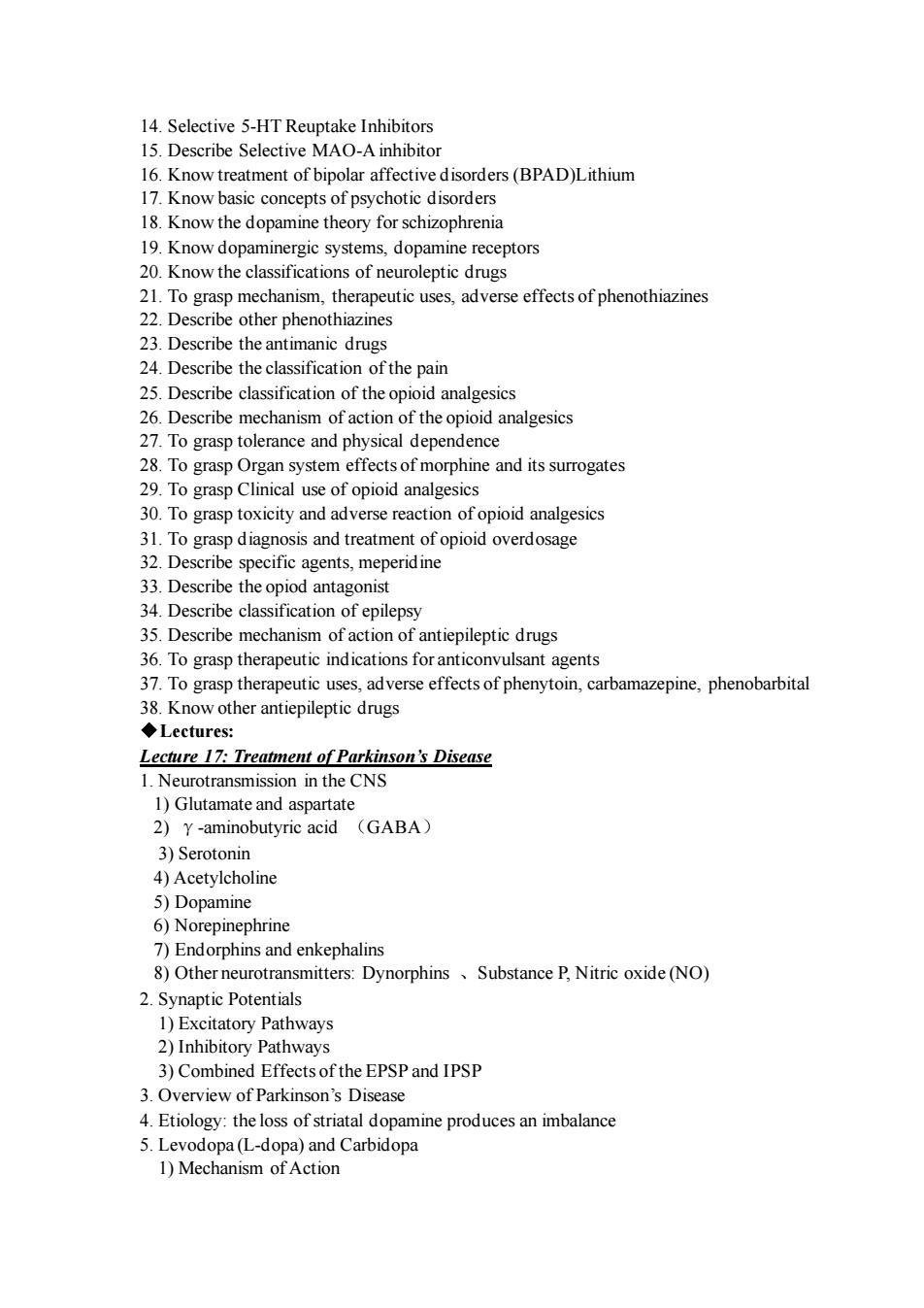
14 Selective 5-HT Reuntake inhibitor 15.Describe Selective MAO-Ainhibito 16.Know treatment of bipolar affective disorders(BPAD)Lithium 17.Know basic concepts of psychotic disorders 18.Know the dopamine theory for schizophrenia 19.Know dopaminergic systems,dopamine receptors 20.Know the assifications of 21.To grasp mechanism,therapeutic uses adverse effects ofphenothiazines 22.Describe other phenothiazines 23 Describe the antimanic drugs 24.Describe the classification of the pain 25.Describe classification of the opioid anal sics 26.Describe mechanism of action of the opioid analgesics 27.To grasp tolerance and physical dependence 28.To grasp Organ system effects of morphine and its surrogates 29.To grasp Clinical use of opioid analgesics 30.To grasp toxicity and adverse reaction of opioid analgesics osis and treatment of opioid overdosage 33.Describe the opiod antagonist 34.Describe classification of epilepsy 35.Describe mechanism of action of antiepileptic drugs 3.To grasp therapeutic indicat ons fo ticonv lsa sents 37.To grasp therapeutic uses,adverse effects of phenytoin,carbamazepine,phenobarbital 38.Know other antiepileptic drugs ◆Lectures: Lecture 17:Treatment of Parkinson's Disease 1.Neurotransmission in the CNS 1)Glutamate and (GABA) 3)Serotonin 4)Acetylcholine 5)Dopamine 6)No ephrine 7)Endorphins and enkephalins 8)Other neurotransmitters:Dynorphins Substance P.Nitric oxide(NO) 2 Synantic Potentials 1)Excitatory Pathways 2)Inhibitory Pathy 3)Combined Effectsof the EPSP and IPSP 3.Overview of Parkinson's Disease 4.Etiology:the loss of striatal dopamine produces an imbalance 5.Levodopa(L-dopa)and Carbidopa 1)Mechanism of Action
14. Selective 5-HT Reuptake Inhibitors 15. Describe Selective MAO-A inhibitor 16. Know treatment of bipolar affective disorders (BPAD)Lithium 17. Know basic concepts of psychotic disorders 18. Know the dopamine theory for schizophrenia 19. Know dopaminergic systems, dopamine receptors 20. Know the classifications of neuroleptic drugs 21. To grasp mechanism, therapeutic uses, adverse effects of phenothiazines 22. Describe other phenothiazines 23. Describe the antimanic drugs 24. Describe the classification of the pain 25. Describe classification of the opioid analgesics 26. Describe mechanism of action of the opioid analgesics 27. To grasp tolerance and physical dependence 28. To grasp Organ system effects of morphine and its surrogates 29. To grasp Clinical use of opioid analgesics 30. To grasp toxicity and adverse reaction of opioid analgesics 31. To grasp diagnosis and treatment of opioid overdosage 32. Describe specific agents, meperidine 33. Describe the opiod antagonist 34. Describe classification of epilepsy 35. Describe mechanism of action of antiepileptic drugs 36. To grasp therapeutic indications for anticonvulsant agents 37. To grasp therapeutic uses, adverse effects of phenytoin, carbamazepine, phenobarbital 38. Know other antiepileptic drugs ◆Lectures: Lecture 17: Treatment of Parkinson’s Disease 1. Neurotransmission in the CNS 1) Glutamate and aspartate 2) γ-aminobutyric acid (GABA) 3) Serotonin 4) Acetylcholine 5) Dopamine 6) Norepinephrine 7) Endorphins and enkephalins 8) Other neurotransmitters: Dynorphins 、Substance P, Nitric oxide (NO) 2. Synaptic Potentials 1) Excitatory Pathways 2) Inhibitory Pathways 3) Combined Effects of the EPSP and IPSP 3. Overview of Parkinson’s Disease 4. Etiology: the loss of striatal dopamine produces an imbalance 5. Levodopa (L-dopa) and Carbidopa 1) Mechanism of Action

2)Fate of Administered L-dopa 3)Ther 5)Drug Interactions 6)Contraindications 6.Specific Agents 1)Dopa nine Ago nists:Bromocriptine 2)M inhib tors:ra 1-O-Methyl Transferase Inhibitors:tolcapone and entacapone 4)Anticholinergic Drugs Lecture 18:Anxiolytic and Hypnotic Drugs 1.Definition of Sedativesand Hypnotics ses of sleep zodiazepine Diazepam 1)Classification 2)Pharmacokinetics 3)Mechanism of benzodiazepines 4)Therapeutie Uses 5)Adverse Effect 6)Tolerance and Dependence 7)Drug Interactions 8)Characteristics of different drugs 4.Benzodiazepines Antagonist- --Flumazenil 1)Classification 2)Pharmacokinetics 3)Mechanism of benzodiazepines 4)Therapeutic Uses 5)Adv 6.Other Sedative-Hypnotics Lecture 19:Antidepressants drugs 1.The classification of affective disorders(Mania,depression) 2.the mechanism of depression 1)Monoamine theory of depression 2)The other theory of depression 3.Tricyclic Antidepressants 1)Pharmacologic effects and mechanism of action 2)Clinical uses 3)Side effects Tetracyclic 4.Selective 5-HT R 6.Treatment of bipolar affective disorders(BPAD)Lithium 1)Mechanism of action 2)Indictions
2) Fate of Administered L-dopa 3) Therapeutic Uses 4) Adverse Effects 5) Drug Interactions 6) Contraindications 6. Specific Agents 1) Dopamine Agonists : Bromocriptine 2) Monoamine oxidase inhibitors: rasagiline 3) Catechol-O-Methyl Transferase Inhibitors :tolcapone and entacapone 4) Anticholinergic Drugs Lecture 18: Anxiolytic and Hypnotic Drugs 1. Definition of Sedatives and Hypnotics 2. Two phases of sleep 3. Benzodiazepines----------Diazepam 1) Classification 2) Pharmacokinetics 3) Mechanism of benzodiazepines 4) Therapeutic Uses 5) Adverse Effects 6) Tolerance and Dependence 7) Drug Interactions 8) Characteristics of different drugs 4. Benzodiazepines Antagonist -----------Flumazenil 5. Barbiturates 1) Classification 2) Pharmacokinetics 3) Mechanism of benzodiazepines 4) Therapeutic Uses 5) Adverse Effects 6. Other Sedative-Hypnotics Lecture 19: Antidepressants drugs 1. The classification of affective disorders(Mania,depression) 2. the mechanism of depression 1) Monoamine theory of depression 2) The other theory of depression 3. Tricyclic Antidepressants 1) Pharmacologic effects and mechanism of action 2) Clinical uses 3) Side effects Tetracyclic 4. Selective 5-HT Reuptake Inhibitors 5. Selective MAO-A inhibitor 6. Treatment of bipolar affective disorders (BPAD)Lithium 1) Mechanism of action 2) Indictions

3)Adverse effects Lecture 20:Neuroleptic drugs 1.Basic concepts of psychotic disorders 2.The Dopamine theory for Schizophrenia 3.The introduction for Dopaminergic Systems 4.The introduction for Dopamine Receptors 5.The classification of Neuroleptic drugs 6 Mode of drugsaction 1)Depamine receptor-blocking activity in brair 2)Serotonin receptor-blocking activity in brain 7 Phenothiazines 1)Chemistry ogical Effects 3)Clinical Uses 4)Side Effects 8.Other phenothiazines 9.The Antimanic Drugs(Lithium carbonate 1)Pharma okin 2)Pharmac logical Effects and Mechanism ofAction 3)Clinical Uses 4)Side Effects and Intoxication Lecture 21:Opioid analgesics and antagonists 1.The classification of the 2.Clas sification of the opioid analgesics 3.Mechanism of action of the opioid analgesics 4 Tolerance and physical dependence 5.Organ system effects of morphine and its surrogates 1)Central ne system effects 2)Peripheral 6.Clinical use of opioid analgesics 7.Toxicity and adverse reaction of opioid analgesics 8.Diagnosis and treatment of opioid overdosage 9.Contraindication and cautions 1)Use of pu s in therapy nist uith woak ial agonists 2)Use in patients with head injuries 3)Use during pregnancy 4)Use in patients with impaired pulmonary function 5)Use in patients with impaired hepatic or renal function 6)Use in atients with endoc 10.Specific agents,Meperidine 11.The opiod antagonist Lecture 22:Drugs Used to treat epilepsy 1.Overview of epilepsy 2 Classification ofe epsy
3) Adverse effects Lecture 20: Neuroleptic drugs 1. Basic concepts of psychotic disorders 2. The Dopamine theory for Schizophrenia 3. The introduction for Dopaminergic Systems 4. The introduction for Dopamine Receptors 5. The classifications of Neuroleptic drugs 6. Mode of drugs action 1) Depamine receptor-blocking activity in brain 2)Serotonin receptor-blocking activity in brain 7. Phenothiazines 1) Chemistry 2) Pharmacological Effects 3) Clinical Uses 4) Side Effects 8. Other phenothiazines 9. The Antimanic Drugs(Lithium carbonate 1) Pharmacokinetics 2) Pharmacological Effects and Mechanism of Action 3) Clinical Uses 4) Side Effects and Intoxication Lecture 21: Opioid Analgesics and Antagonists 1. The classification of the pain 2. Classification of the opioid analgesics 3. Mechanism of action of the opioid analgesics 4. Tolerance and Physical Dependence 5. Organ system effects of morphine and its surrogates 1) Central nervous system effects 2) Peripheral effects 6. Clinical use of opioid analgesics 7. Toxicity and adverse reaction of opioid analgesics 8. Diagnosis and treatment of opioid overdosage 9. Contraindication and cautions in therapy 1) Use of pure agonists with weak partial agonists 2) Use in patients with head injuries 3) Use during pregnancy 4) Use in patients with impaired pulmonary function 5) Use in patients with impaired hepatic or renal function 6) Use in patients with endocrine disease 10. Specific agents, Meperidine 11. The opiod antagonist Lecture 22:Drugs Used to Treat Epilepsy 1. Overview of epilepsy 2. Classification of epilepsy

1)Partial Simple partial Comple: 2)Generalized Tonic-clonic (grand mal) Absence (petit mal) Myoclonic Febrile seizures Status epilepticus 3.Mechanism of action of antiepileptic drugs 4.Antiepileptic drugs 1)Therapeutic indications for anticonvulsant agents Phenytoin 3)Carbamazepine 4)Phenobarbital 5)Other antiepileptic drugs Primidone Valproic cid Benzod iazepines Gabapentin Lamotrigine 5.Seminar/Student Presentation/Group Discussion on the topic of this Unit ◆Practicals:: 1.Compare the effect's intensity of local anesthetic (3 hours required) 2.Effects of chlorpromazine on electrostimulating mouse (3 hours required) 3.The antielectraconvulsive effect of Phenytoin sodium and Phenobarbital sodium IV.Drugs Affecting the Cardiovascular System ◆Objectives 1.Describe pathophysiology of heart failure 2.Describe classification of drug for treatment of CHF 3.To grasp mechanism of positive inotropic effect,pharmacological effects,clinical uses, unto rd effects,prevention and cure of intoxication of digitalis 4.Knov source and d chem h cokinetics,and administration ofdigitalis 5,DeSeibeHcalnicaniofCHFofp-a时rencrgcieceptorstimlaios 6.Describe treatment of cHF of phosphodieterase Inhibitors 7.Describe treatment of CHF of diuretics drugs 8.Describe treatment of CHF of arterial and venous vasodilators 9.Describe tofcHeofd rugs that interfere with the ACEI 10.To grasp the classification of arrhythmias 11.Describe transmembrane potential and physiological properties of cardiac cell 12.Describe mechanism ofarrhythmias 13.Describe basic action of antiarrhythmics
1) Partial Simple partial Complex partial 2) Generalized Tonic-clonic (grand mal) Absence (petit mal) Myoclonic Febrile seizures Status epilepticus 3. Mechanism of action of antiepileptic drugs 4. Antiepileptic drugs 1) Therapeutic indications for anticonvulsant agents 2) Phenytoin 3) Carbamazepine 4) Phenobarbital 5) Other antiepileptic drugs Primidone Valproic acid Ethosuximide Benzodiazepines Gabapentin Lamotrigine 5. Seminar/Student Presentation/Group Discussion on the topic of this Unit ◆Practicals: 1. Compare the effect’s intensity of local anesthetic (3 hours required) 2. Effects of chlorpromazine on electrostimulating mouse (3 hours required) 3. The antielectraconvulsive effect of Phenytoin sodium and Phenobarbital sodium IV. Drugs Affecting the Cardiovascular System ◆Objectives: 1. Describe pathophysiology of heart failure 2. Describe classification of drug for treatment of CHF 3. To grasp mechanism of positive inotropic effect, pharmacological effects, clinical uses, untoward effects, prevention and cure of intoxication of digitalis 4. Know source and chemistry , pharmacokinetics, and administration of digitalis 5. Describe treatment of CHF of β- adrenergic receptor stimulators 6. Describe treatment of CHF of phosphodieterase Inhibitors 7. Describe treatment of CHF of diuretics drugs 8. Describe treatment of CHF of arterial and venous vasodilators 9. Describe treatment of CHF of drugs that interfere with the ACEI 10. To grasp the classification of arrhythmias 11. Describe transmembrane potential and physiological properties of cardiac cell 12. Describe mechanism of arrhythmias 13. Describe basic action of antiarrhythmics
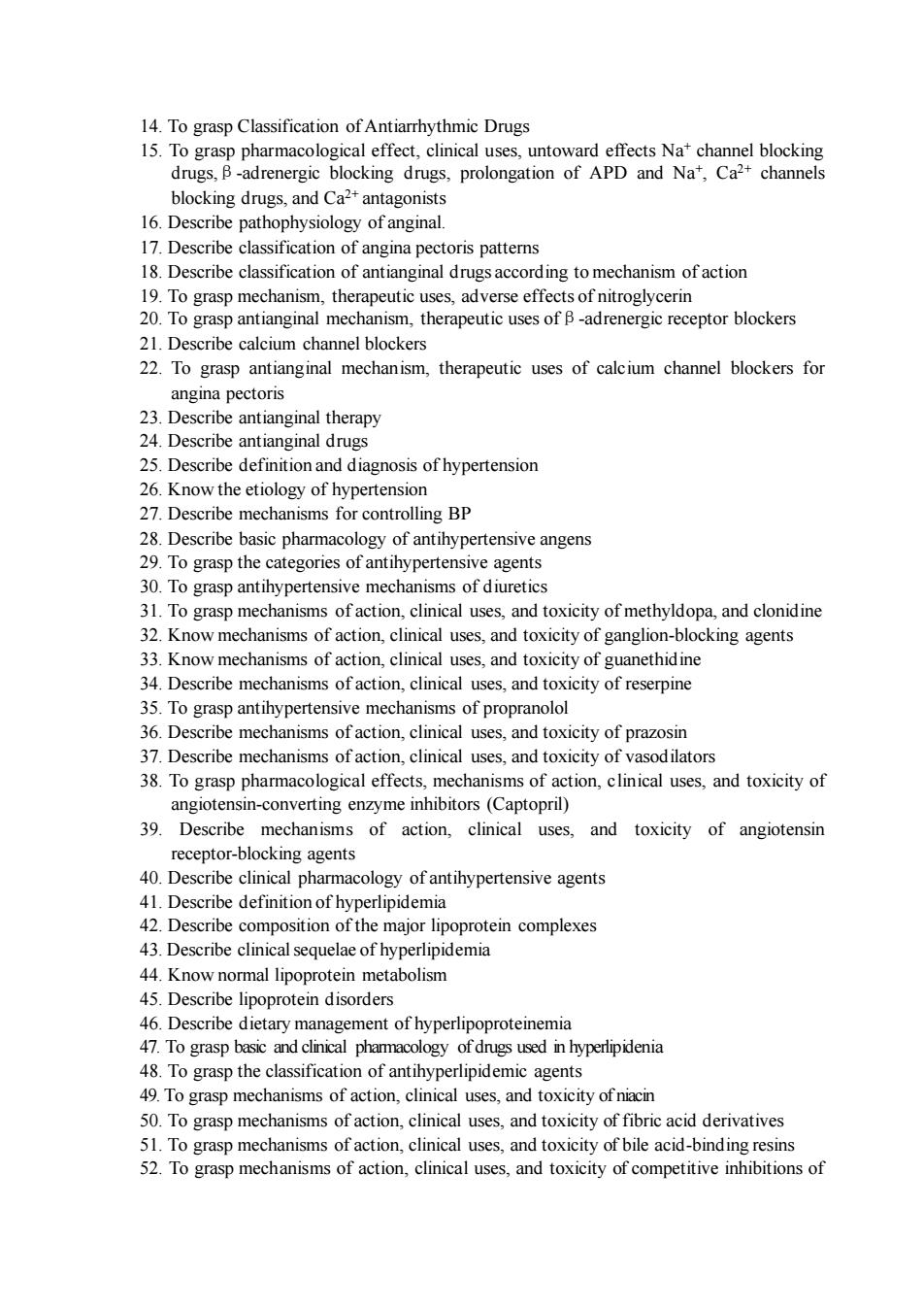
14.To grasp Classification of Antiarrhythmic Drugs drugs,F renergic ocking drus prolonation of APDnd Nan channels blocking drugs,and Ca2+antagonists 16.Describe pathophysiology of anginal. 17.Describe classification of angina pectoris patterns 18.Describe classificatio of antianginal drugs according to mechanism of actior 19.To grasp mechanism,therapeutic uses,adverse effects of nitroglycerin 20.To grasp antianginal mechanism,therapeutic uses of B-adrenergic receptor blockers 21.Describe calcium channel blockers 22.To grasp antianginal mechanism,therapeutic uses of calcium channel blockers for pectoris 23.Describe antianginal therapy 24.Describe antianginal drugs 25.Describe definition and diagnosis of hypertension 26.Know the etiology of hypertension 27.Describe mechanisms for controlling BP 29.To grasp the categories of antihypertensive agents 30.To grasp antihypertensive mechanisms of diuretics 31.To grasp mechanisms of action,clinical uses,and toxicity of methyldopa,and clonidine 32.Know mechanisms of action,clinical uses,and toxicity of ganglion-blocking agents 33.Know mechani isms of actio on,clinical uses,and to 34.Describe mechanisms ofaction,clinical uses,and to guanethid ine city of reserpin 35.To grasp antihypertensive mechanisms of propranolol 36.Describe mechanisms of action,clinical uses,and toxicity of prazosin 37.Describe mechanisms of action,clinical uses,and toxicity of vasodilators 38.T0g gical effects mechanism s of action,clinical uses,and toxicity of angiot verting enzyme inhib itors (C aptopril) 39.Describe mechanisms of action,clinical uses,and toxicity of angiotensin receptor-blocking agents 40.Describe clinical pharmacology of antihypertensive agents rotein complexes 43.Describe clini al sequelae of hyperlipidemi 44.Know normal lipoprotein metabolism 45.Describe lipoprotein disorders 46 describe dietary management of hyperlipop 47.To gras 48.To grasp the classification of antihyperlipidemic agents 49.To grasp mechanisms of action,clinical uses,and toxicity of niacin 50.To grasp mechanisms of action,clinical uses,and toxicity of fibric acid derivatives 51.To grasp mechanisms of action,clinical uses,and toxicity of bile acid-binding resins 52.To grasp mechanisms of action,clinical uses,and toxicity of competitive inhibitions of
14. To grasp Classification of Antiarrhythmic Drugs 15. To grasp pharmacological effect, clinical uses, untoward effects Na+ channel blocking drugs,β-adrenergic blocking drugs, prolongation of APD and Na+ , Ca2+ channels blocking drugs, and Ca2+ antagonists 16. Describe pathophysiology of anginal. 17. Describe classification of angina pectoris patterns 18. Describe classification of antianginal drugs according to mechanism of action 19. To grasp mechanism, therapeutic uses, adverse effects of nitroglycerin 20. To grasp antianginal mechanism, therapeutic uses ofβ-adrenergic receptor blockers 21. Describe calcium channel blockers 22. To grasp antianginal mechanism, therapeutic uses of calcium channel blockers for angina pectoris 23. Describe antianginal therapy 24. Describe antianginal drugs 25. Describe definition and diagnosis of hypertension 26. Know the etiology of hypertension 27. Describe mechanisms for controlling BP 28. Describe basic pharmacology of antihypertensive angens 29. To grasp the categories of antihypertensive agents 30. To grasp antihypertensive mechanisms of diuretics 31. To grasp mechanisms of action, clinical uses, and toxicity of methyldopa, and clonidine 32. Know mechanisms of action, clinical uses, and toxicity of ganglion-blocking agents 33. Know mechanisms of action, clinical uses, and toxicity of guanethidine 34. Describe mechanisms of action, clinical uses, and toxicity of reserpine 35. To grasp antihypertensive mechanisms of propranolol 36. Describe mechanisms of action, clinical uses, and toxicity of prazosin 37. Describe mechanisms of action, clinical uses, and toxicity of vasodilators 38. To grasp pharmacological effects, mechanisms of action, clinical uses, and toxicity of angiotensin-converting enzyme inhibitors (Captopril) 39. Describe mechanisms of action, clinical uses, and toxicity of angiotensin receptor-blocking agents 40. Describe clinical pharmacology of antihypertensive agents 41. Describe definition of hyperlipidemia 42. Describe composition of the major lipoprotein complexes 43. Describe clinical sequelae of hyperlipidemia 44. Know normal lipoprotein metabolism 45. Describe lipoprotein disorders 46. Describe dietary management of hyperlipoproteinemia 47. To grasp basic and clinical pharmacology of drugs used in hyperlipidenia 48. To grasp the classification of antihyperlipidemic agents 49. To grasp mechanisms of action, clinical uses, and toxicity of niacin 50. To grasp mechanisms of action, clinical uses, and toxicity of fibric acid derivatives 51. To grasp mechanisms of action, clinical uses, and toxicity of bile acid-binding resins 52. To grasp mechanisms of action, clinical uses, and toxicity of competitive inhibitions of
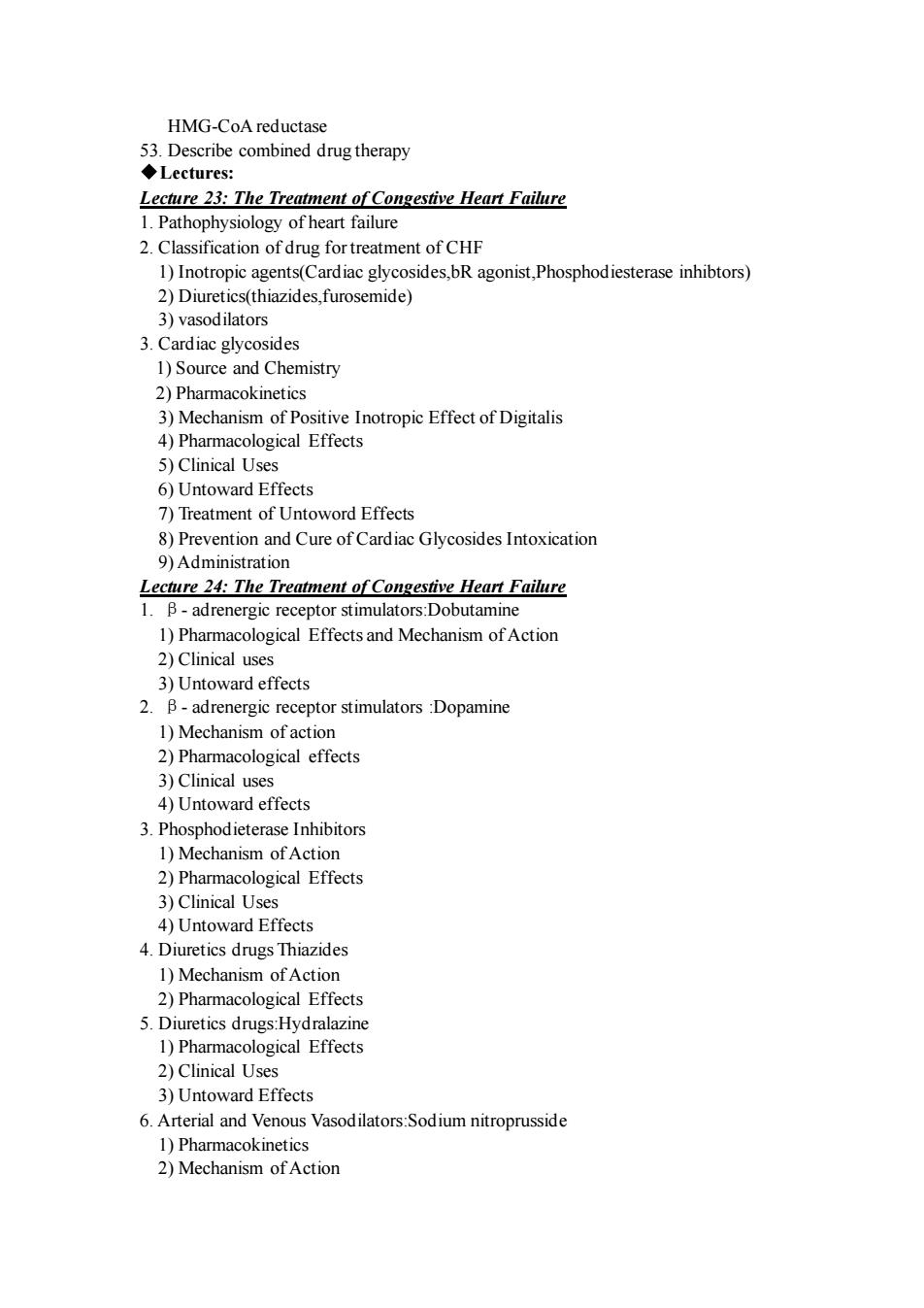
HMG-Coa reductase 53 Des combined drug therapy ◆Lectur Lecture 23:The Treatment of Congestive Heart Failure 1.Pathophysiology of heart failure 2.Classification of drug for treatment of CHF 1)Inot sides,bR agonist,Phosphodiesterase inhibtors) 2)Diure (th 3)vasodilators 3.Cardiac glycosides 1)Source and Chemistry 2)Pharmacokinetics 3)Mechanism of Positive Inotropic Effect of Digitalis 4)Pharma 5)Clinical Uses 6)Untoward Effects 7)Treatment of Untoword Effects ) ntion and Cure of Cardiac Glycosides Intoxication on Lecture 24:The Treatment of Congestive Heart Failure 1.B-adrenergic receptor stimulators:Dobutamine 1)Pharmacological Effects and Mechanism ofAction 2)Clinical use 3)Untoward effects 2 adrenergic receptor stimulatorsDopamine 1)Mechanism ofaction 2)Pharmacological effects 3)Clinical uses 4)Untoward effects 3.Phosphodieterase Inhibitors 1)Mechanism ofAction 2)Pharmacological Effects 3)Clinical Uses 4)Untoward Effects 4.Diuretics drugs Thiazides 1)Mechanism ofAction 2)Pharmacological Effects 5.Diuretics drugs:Hydralazine 1)Pharmacological Effects 2)Cli ical Us 3)Untoward Effects 6.Arterial and Venous Vasodilators:Sodium nitroprusside 1)Pharmacokinetics 2)Mechanism of action
HMG-CoA reductase 53. Describe combined drug therapy ◆Lectures: Lecture 23: The Treatment of Congestive Heart Failure 1. Pathophysiology of heart failure 2. Classification of drug for treatment of CHF 1) Inotropic agents(Cardiac glycosides,bR agonist,Phosphodiesterase inhibtors) 2) Diuretics(thiazides,furosemide) 3) vasodilators 3. Cardiac glycosides 1) Source and Chemistry 2) Pharmacokinetics 3) Mechanism of Positive Inotropic Effect of Digitalis 4) Pharmacological Effects 5) Clinical Uses 6) Untoward Effects 7) Treatment of Untoword Effects 8) Prevention and Cure of Cardiac Glycosides Intoxication 9) Administration Lecture 24: The Treatment of Congestive Heart Failure 1. β- adrenergic receptor stimulators:Dobutamine 1) Pharmacological Effects and Mechanism of Action 2) Clinical uses 3) Untoward effects 2. β- adrenergic receptor stimulators :Dopamine 1) Mechanism of action 2) Pharmacological effects 3) Clinical uses 4) Untoward effects 3. Phosphodieterase Inhibitors 1) Mechanism of Action 2) Pharmacological Effects 3) Clinical Uses 4) Untoward Effects 4. Diuretics drugs Thiazides 1) Mechanism of Action 2) Pharmacological Effects 5. Diuretics drugs:Hydralazine 1) Pharmacological Effects 2) Clinical Uses 3) Untoward Effects 6. Arterial and Venous Vasodilators:Sodium nitroprusside 1) Pharmacokinetics 2) Mechanism of Action